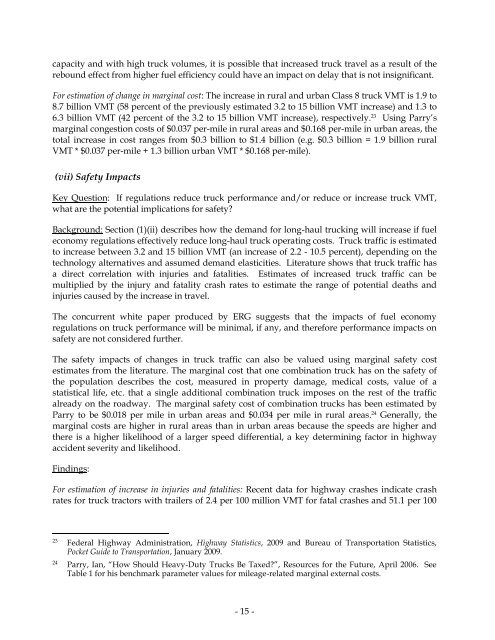Assessment of Fuel Economy Technologies for Medium and Heavy ...
Assessment of Fuel Economy Technologies for Medium and Heavy ...
Assessment of Fuel Economy Technologies for Medium and Heavy ...
You also want an ePaper? Increase the reach of your titles
YUMPU automatically turns print PDFs into web optimized ePapers that Google loves.
capacity <strong>and</strong> with high truck volumes, it is possible that increased truck travel as a result <strong>of</strong> the<br />
rebound effect from higher fuel efficiency could have an impact on delay that is not insignificant.<br />
For estimation <strong>of</strong> change in marginal cost: The increase in rural <strong>and</strong> urban Class 8 truck VMT is 1.9 to<br />
8.7 billion VMT (58 percent <strong>of</strong> the previously estimated 3.2 to 15 billion VMT increase) <strong>and</strong> 1.3 to<br />
6.3 billion VMT (42 percent <strong>of</strong> the 3.2 to 15 billion VMT increase), respectively. 23 Using Parry‘s<br />
marginal congestion costs <strong>of</strong> $0.037 per-mile in rural areas <strong>and</strong> $0.168 per-mile in urban areas, the<br />
total increase in cost ranges from $0.3 billion to $1.4 billion (e.g. $0.3 billion = 1.9 billion rural<br />
VMT * $0.037 per-mile + 1.3 billion urban VMT * $0.168 per-mile).<br />
(vii) Safety Impacts<br />
Key Question: If regulations reduce truck per<strong>for</strong>mance <strong>and</strong>/or reduce or increase truck VMT,<br />
what are the potential implications <strong>for</strong> safety<br />
Background: Section (1)(ii) describes how the dem<strong>and</strong> <strong>for</strong> long-haul trucking will increase if fuel<br />
economy regulations effectively reduce long-haul truck operating costs. Truck traffic is estimated<br />
to increase between 3.2 <strong>and</strong> 15 billion VMT (an increase <strong>of</strong> 2.2 - 10.5 percent), depending on the<br />
technology alternatives <strong>and</strong> assumed dem<strong>and</strong> elasticities. Literature shows that truck traffic has<br />
a direct correlation with injuries <strong>and</strong> fatalities. Estimates <strong>of</strong> increased truck traffic can be<br />
multiplied by the injury <strong>and</strong> fatality crash rates to estimate the range <strong>of</strong> potential deaths <strong>and</strong><br />
injuries caused by the increase in travel.<br />
The concurrent white paper produced by ERG suggests that the impacts <strong>of</strong> fuel economy<br />
regulations on truck per<strong>for</strong>mance will be minimal, if any, <strong>and</strong> there<strong>for</strong>e per<strong>for</strong>mance impacts on<br />
safety are not considered further.<br />
The safety impacts <strong>of</strong> changes in truck traffic can also be valued using marginal safety cost<br />
estimates from the literature. The marginal cost that one combination truck has on the safety <strong>of</strong><br />
the population describes the cost, measured in property damage, medical costs, value <strong>of</strong> a<br />
statistical life, etc. that a single additional combination truck imposes on the rest <strong>of</strong> the traffic<br />
already on the roadway. The marginal safety cost <strong>of</strong> combination trucks has been estimated by<br />
Parry to be $0.018 per mile in urban areas <strong>and</strong> $0.034 per mile in rural areas. 24 Generally, the<br />
marginal costs are higher in rural areas than in urban areas because the speeds are higher <strong>and</strong><br />
there is a higher likelihood <strong>of</strong> a larger speed differential, a key determining factor in highway<br />
accident severity <strong>and</strong> likelihood.<br />
Findings:<br />
For estimation <strong>of</strong> increase in injuries <strong>and</strong> fatalities: Recent data <strong>for</strong> highway crashes indicate crash<br />
rates <strong>for</strong> truck tractors with trailers <strong>of</strong> 2.4 per 100 million VMT <strong>for</strong> fatal crashes <strong>and</strong> 51.1 per 100<br />
23<br />
Federal Highway Administration, Highway Statistics, 2009 <strong>and</strong> Bureau <strong>of</strong> Transportation Statistics,<br />
Pocket Guide to Transportation, January 2009.<br />
24<br />
Parry, Ian, ―How Should <strong>Heavy</strong>-Duty Trucks Be Taxed‖, Resources <strong>for</strong> the Future, April 2006. See<br />
Table 1 <strong>for</strong> his benchmark parameter values <strong>for</strong> mileage-related marginal external costs.<br />
- 15 -
















